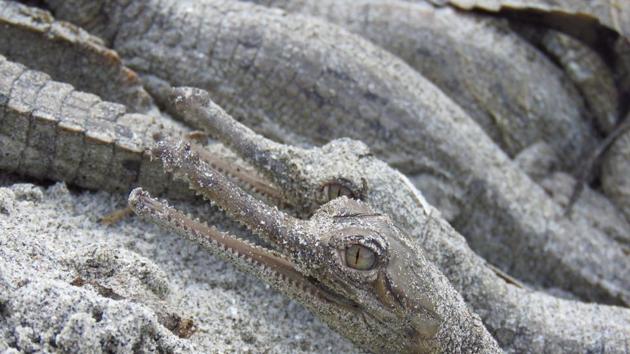116 endangered gharial hatchlings born in Bihar’s Gandak River
Samir Kumar Sinha, deputy director of the Wildlife Trust of India (WTI), said the river has registered successful breeding of the endangered gharials for three consecutive years now.
On World Crocodile Day on Wednesday, there is good news from Bihar.

The birth of 116 gharials on the Gandak River, which flows into Bihar from Nepal and covers over 320km in the state, has made it an occasion for celebration.
Samir Kumar Sinha, deputy director of the Wildlife Trust of India (WTI), said the river has registered successful breeding of the endangered gharials for three consecutive years now.
“It is indeed great news from the Gandak River to make World Crocodile Day celebration special. We were really happy to see little gharials coming out from under the sand. In March, we had carried out a survey and the number came to 260, now it will grow further,” Sinha said.
“There was a time when gharials were widespread across the Indian subcontinent, but the number dropped alarmingly by 2006 to put them under the endangered list,” he added.
Getting a cue from the congregation of adult male and female gharials, WTI researchers identified three sites along the river with chances of crocodile nesting this year.
“One of the potential sites was downstream Ratwal bridge, where we recorded 8-10 adult females in March 2020 survey,” Subrat Kumar Behera of WTI, who led the survey team, said.
“We engaged nest watchers from local communities to keep close eyes on gharial nesting. It is important because the nests often get eroded due to a sudden rise in water level and fast current after the release of water from the barrage at Valmiki Nagar in the last week of March,” Behera added.
In early April, three nests with 94 eggs of the fish-eating crocodiles were located and shifted to a safe place away from the bank to protect against the erosion.
Amid the coronavirus lockdown, a team of four local watchers looked after the nest till the eggs successfully hatched into 86 gharials on June 14 after 65-70 days of incubation.
“The hatchlings (gharial babies) were released in the river exactly where the nests were located first. The baby hatchlings were united with the mother,” said Sinha.
One nest in the same area, which remained undetected by the team, also hatched with 30 more babies. So, 116 gharial babies have been added to the Gandak River.
WTI’s Sinha, who is also the member of the state board for wildlife chaired by chief minister Nitish Kumar, said the Gandak gharial conservation project had started in 2014 and there has been a consistent and good increase in the number of the critically endangered species in the last few years.
“We had released 30 captive-born gharials from the Patna zoo into the river and started monitoring them. We soon discovered that the Gandak provided the natural breeding ground for them. Their number has been consistently on the rise,” he added.
Bihar’s forest department started a project with WTI to strengthen the Gandak’s gharial population by releasing the captive-born crocodiles into the river in 2014-15, followed by protection of nests engaging locals.
The state holds global importance as the Gandak hosts the second largest population of these reptiles in its current distribution range in India, Nepal and Bangladesh, said Sinha.
The State Board for Wildlife, chaired by chief minister Nitish Kumar, has given nod to notify a 150-km stretch of the river as a Conservation Reserve.
It will help not only the critically endangered gharial but also India’s aquatic animal – the Ganges River Dolphin. In a survey in 2018, 155 dolphins were recorded in the river.



